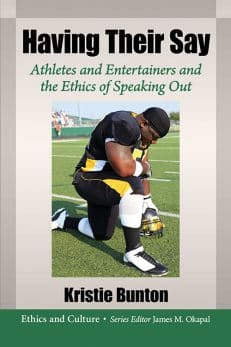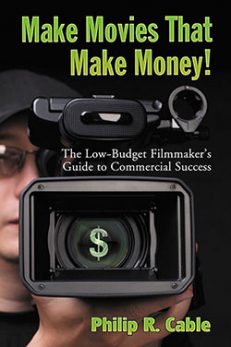Make Movies That Make Money!
The Low-Budget Filmmaker’s Guide to Commercial Success
Original price was: $39.95.$31.99Current price is: $31.99.
In stock
About the Book
The term “low-budget” can refer to anything from a $10 million indie flick to a student film produced on borrowed equipment with little or no money. Low budget filmmakers can range from seasoned auteurs attempting to shed the shackles of major studio control to novice talents trying to break into the industry.
Designed for would-be filmmakers of all experience levels, this book explains how to make a good, commercially successful, low-budget movie in the current multi-million dollar Hollywood climate. The purpose is not only to show how to get movies made and distributed, but also how to maximize a film’s potential for significant profit.
Written in practical, understandable terms, the book covers everything from commercially viable genres to the most efficient film and video formats, along with tips on hiring stars, pursuing investors, distributing and marketing a film, and keeping track of expenses.
About the Author(s)
Bibliographic Details
Philip R. Cable
Format: softcover (6 x 9)
Pages: 240
Bibliographic Info: appendices, bibliography, index
Copyright Date: 2009
pISBN: 978-0-7864-4163-1
eISBN: 978-0-7864-5346-7
Imprint: McFarland
Table of Contents
Acknowledgments vii
Preface 1
I. GETTING STARTED
1. Realistic Expectations 3
2. Is There a Need for Your Movie? 5
3. What Kind of Movie Makes Money? 6
4. What Sells Each Genre? 8
5. Contact a Distributor Now! 9
6. Letters of Intent Can Make, or Break, Your Movie 10
7. Show Me the Money! 12
8. Corporation or Limited Partnership: Which Is Right for You? 13
9. Selling Yourself Isn’t Selling Out 15
10. Investors Buy the Sizzle, Not Just the Steak 18
11. Sizing Up an Investor 23
12. An Investors Proposal That Makes Sense 25
13. Investor Contracts: Keep It Simple 38
14. The Budget Dictates the Movie You Make and Your Profit Potential 41
15. In What Format Should You Shoot Your Movie? 43
16. Dangerous People to Watch Out For 45
17. You’re Not Ready Until You’re Ready 47
18. Ten Hard Lessons About Getting Ready 48
19. Flashback, Part One 50
II. PRE-PRODUCTION
20. The Budget: Is There Ever Enough Money? 53
21. Over-Ambition + Inexperience = Failure 54
22. Write a Script That Helps Your Movie, Not Hinders It 54
23. Plot Structure That Works 87
24. Dialogue Is Just Words, Unless… 95
25. What to Minimize 96
26. Why Scene Length Is Vital 97
27. Everybody’s Got a Talented “Relative” 97
28. Union Actors, Non-Union, and Financial Core 98
29. You Can’t Trust Actors’ Resumes 100
30. Auditions Don’t Have to Be Agony 102
31. Casting: Not for the Faint of Heart 104
32. Do You Need a Star to Sell Your Movie? 105
33. How Do You Get a Star? 106
34. There’s Always an Armchair Role with a Star’s Name on It 107
35. The Crew Is Crucial 108
36. Actors’ and Crew’s Contracts 109
37. Insurance 114
38. Do You Need a Completion Bond? 116
39. Locations and Sets 117
40. Planning a Logical Shooting Schedule 119
41. Product Placement 124
42. A Cast “Read Through” Is Important 125
43. It’s Not Real Until It Happens 126
44. Practice Being Bad in Order to Be Good 126
45. Ten Hard Lessons About Pre-Production 127
46. Flashback, Part Two 128
III. PRODUCTION
47. Sudden Offers to Help 131
48. If You Don’t Know Your Craft, You’d Better Learn It Now 131
49. Plan Your Shots 132
50. Continuity 133
51. Permits 133
52. Get a Good Production Assistant and Save Yourself a Lot of Aggravation 134
53. A Director Is a Leader; Be One 135
54. A Director Is Also a Peacemaker 135
55. The Three-Quarter Actor 136
56. Always Have Another Actor in the Wings 137
57. Keep a Tight Rein on Your Actors or They Will Stampede 138
58. Release Forms 138
59. Keep from Being Sued by Being Careful About What You Film 139
60. Let’s Talk About Errors and Omissions 140
61. What You Do When Everyone Realizes That Filmmaking Is Hard Work 142
62. Cameras 142
63. Affordable Lighting Equipment 143
64. Sound: The Difference Between Success and Disaster 144
65. Basic Camera Techniques That Every Actor and Director Needs to Know 145
66. Effective Lighting Is Not That Hard 147
67. Camera Placement 149
68. Tips on Recording Effective Sound 150
69. Coverage, the Ultimate Protection 151
70. Photos on the Set Are Important 151
71. Meals and Craft Service Can Save Your Production 152
72. Special Effects on the Set 152
73. Plan for Things to Go Wrong 156
74. Ten Hard Lessons About Production 157
75. Flashback, Part Three 158
IV. POST-PRODUCTION
76. Where to Find Affordable Editing 160
77. In What Format Should You Edit? 162
78. Editing Tips 163
79. Sound Effects and Effective Sound 164
80. ADR, the Easy Way 165
81. Where Do You Find Music? 166
82. Music Tips 167
83. Titles and Visual Effects 168
84. Stock Footage 169
85. Ten Hard Lessons About Post-Production 170
86. Flashback, Part Four 171
V. DISTRIBUTION
87. You Can’t Make Dime One Until You Understand How Distribution Actually Works 174
88. The Important Film Markets 176
89. What Kind of Distributor Do You Really Need? 178
90. The Marketplaces for Your Movie 179
91. The Two-and-a-Half Distribution Deals 179
92. Playing Scared Means You’ll Lose the Game 180
93. Being Cheated by a Distributor 181
94. Ten Hard Lessons About Distribution 182
95. Flashback, Part Five 184
VI. IT AIN’T OVER TILL IT’S OVER
96. Movies Are a Neverending Process 187
97. Do Film Festivals Have Any Real Value? 187
98. Promotion, Promotion, Promotion 189
99. Doing Interviews That Will Sell Your Movie 189
100. Keeping Track of Your Profits 191
101. Hold Onto Your Contacts 191
102. Flashback, Part Six 191
VII. FINAL THOUGHTS
103. Personal Observations 193
104. Recommended Reading and Viewing 194
Appendices
A. Script Coverage Companies 197
B. Screen Actors Guild Local Branches 198
C. Motion Picture Insurance Companies 199
D. Product Placement Companies 200
E. Filmmaking Terms 203
F. Distributors 209
Bibliography 219
Index 223
Book Reviews & Awards
“the information about markets is valuable, as are the appendices”—Library Journal; “a fine and highly recommended guide for those who don’t want to be a starving artist”—Midwest Book Review.





